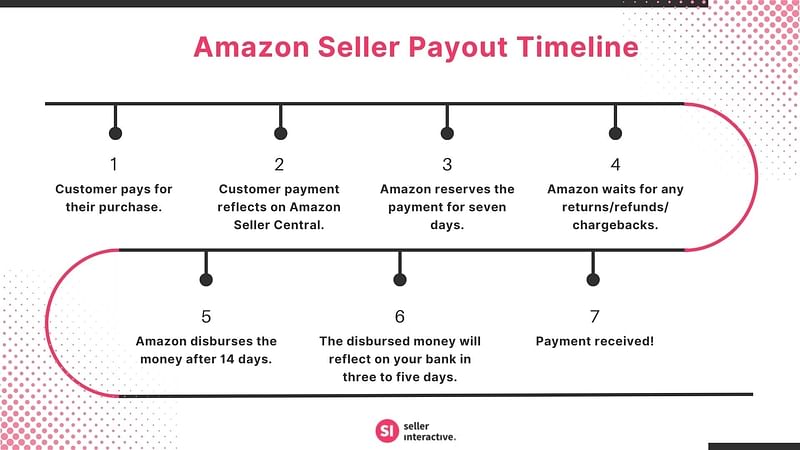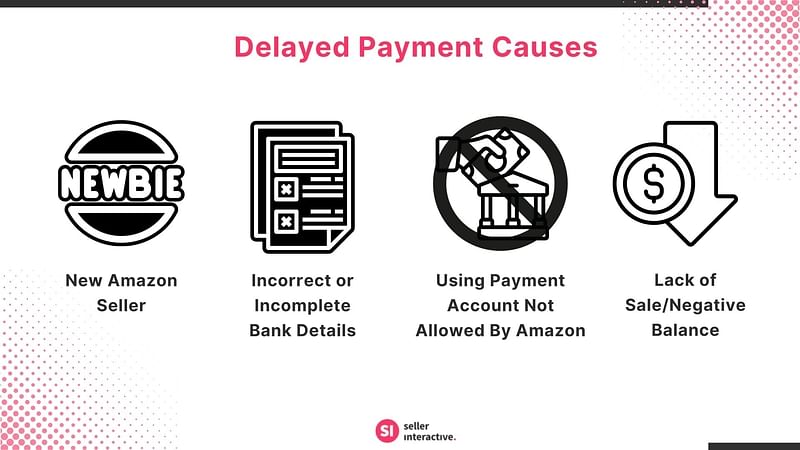
Last updated on November 14th, 2023
 Written by Mohamed Aden
Written by Mohamed Aden
Selling on Amazon can seem daunting, especially when understanding the Amazon seller payment schedule (ASPS). Knowing how and when you’ll receive your hard-earned money is crucial for managing your business effectively.
In this guide, we’ll dive into the ASPS, providing valuable insights and helping you make well-informed decisions for your online business.
To further enhance your understanding of the ASPS, we will also cover disbursement options, factors affecting payment speed, and strategies for managing your cash flow more effectively. When you have a clear understanding of Amazon payouts, you can manage the cash flowing to optimize your online business and maximize your profits.
How Often Does Amazon Pay Out to Sellers?
Amazon typically pays out to sellers every two weeks. However, some factors can affect the exact Amazon seller payout schedule, such as the seller’s tenure, location, and chosen payout method.
Amazon Payout Schedule for Amazon Sellers
Amazon sellers have their own schedule of payouts, and the timeline is illustrated below.

Payment Cycle for Amazon Vendors
Meanwhile, Amazon vendor payments follow a different structure compared to Amazon sellers. As a vendor, there are three payment terms you should remember:
| Payment Terms | Days Vendor Will Receive Payment |
| Net 30 | 30 days |
| Net 60 | 60 days |
| Net 90 | 90 days |
By understanding these payment cycles, you can better anticipate when to expect payments and adapt your business plans accordingly.
Ways To Get Amazon Seller Payouts Faster
Do the payment schedules above seem too long, or do you foresee instances when you need to receive money faster than usual? You can get paid on an earlier disbursement date through these three ways.
| Daily Payout |
| Daily Payout allows for early access to your funds. However, note that you won’t receive a huge payment right away. In this payout method, you will just receive the currently available amount in your account, which is the sales amount for orders sold 14 days ago. To request a daily payout, click the “Request Transfer” button on Seller Central. |
| Next-Day Payout |
| To qualify for Next-Day Payouts, you must meet certain criteria, such as having been a seller for a minimum of 10 years and using a 3rd party instant access solution.
Like Daily Payouts, you won’t receive a lump sum payment the next day but after two days. For instance, if you requested a Next-Day Payout on a Monday, you can receive the money on a Wednesday. Amazon sets aside 20% Amazon account level reserve to cover customer disputes and other claims leading to returns, replacements, or other charges, so you won’t get 100% of your pay for Next-Day Payouts. The 20% amount will be sent to you according to the normal payout schedule every 14 days. |
| Express Payout |
| To be eligible for Express Payouts, you must have a US bank account, reside in America, and have a transaction below $1M. For eligible sellers, Express Payouts provides a faster payment option that does not require waiting five days for funds to arrive in your account. You can receive the payment in just 24 hours. |
A Closer Look At Account Level Reserve
When you request an earlier payout, there’s an amount Amazon withholds for seven days. This money is the Amazon account level reserve.
Amazon has the Account Level Reserve to safeguard its marketplace and protect buyers and sellers from potential risks. The reserve acts as a precautionary measure to cover any potential negative balance that may occur on a seller’s account, such as refunds, chargebacks, or claims.
Through the reserve, Amazon maintains the integrity of the platform, improves customer satisfaction, and gives sellers reassurance that they can fulfill their obligations without financial strain.
Account level reserve amounts vary per seller, and the factors below are what Amazon takes into account in their computation.
Account Age
Account age is a factor that Amazon considers while determining the basis for an account level reserve. This refers to the length of time that an Amazon account has been active. The older the account, the more established and trustworthy it is considered to be.
Disputes
Disputes refer to situations where customers raise concerns or grievances about their purchases or interactions with a seller on Amazon. These disputes could include issues like:
– items not as described
– late deliveries
– problems with refunds
If a seller has a history of disputes, it can negatively impact their account and may result in the need for an account level reserve.
Order Defect Rate (ODR)
The Order Defect Rate is a performance metric that measures a seller’s ability to meet customer expectations and provide a satisfactory buying experience. It particularly checks the following:
- Negative Feedback
- A-To-Z Guarantee Claims
- Credit Card Chargebacks
A high ODR indicates that there have been significant issues with the seller’s orders, and Amazon may require an account level reserve to cover potential refunds or claims.
Account Performance
Account performance encompasses these various aspects of a seller’s performance:
- Customer Feedback
- Seller Metrics
- Amazon’s Policies Compliance
- Timely Shipment
- On-Time Delivery
- Accurate Product Information
If a seller consistently fails to meet Amazon’s performance standards, they may be subjected to an account level reserve to protect customers from potential losses.
| Ways to Avoid High Account Level Reserve |
|
|
Tips for Managing Cash Flow on Amazon
Now that you are well aware of the ASPS, you have a good start in managing your cash flow. Nevertheless, the task does not go without any challenges. Let us help you discover strategies for monitoring and forecasting cash flow, optimizing inventory management, and leveraging Amazon’s tools and resources in this section to avoid any cash flow issues and press on with your business growth.
Use Seller Central Data
Due to the many delays in receiving your payments, such as Amazon account reserves, bank transfer waiting time, and the Amazon 14-day payouts, it’s easy to get lost in your financial data. To stay updated, use the “Payment Dashboard” on your Seller Central account to see real-time data on how much Amazon will pay you and when.
Do Accurate Bookkeeping and Record-Keeping
Incorporate Seller Central data with your books and financial records for better management of, investments, operations costs, and inventory. Accurate bookkeeping and record-keeping will help you manage cash flow efficiently. It also allows you to see the bigger financial picture of your business instead of just looking at the income you’ll acquire from Amazon.
Be Mindful of What Causes Payment Delays

Below are the common causes of delayed Amazon payment. Your knowledge will help you plan better to avoid them.
- New Amazon Seller: As a new Amazon seller, your payment schedule may be delayed because Amazon may need to verify your account and ensure that you have a reputable selling history before releasing funds.
- Incorrect/Incomplete Bank Details: Amazon may need additional time to verify the accuracy of the provided information. This can result in a delay in your payment schedule until the necessary updates are made.
- Using Payment Account Not Allowed by Amazon: Amazon has specific guidelines regarding which payment accounts are allowed for receiving seller payments. If you are using a payment account that is not approved by Amazon, your payment schedule may be delayed until you switch to an approved account.
- Lack of Sale/Negative Balance: If your sales volume is low or if you have a negative balance due to returns or customer refunds, Amazon may delay your payment schedule as they need to ensure that there are sufficient funds to cover any potential liabilities before releasing payments.
Have Multiple Income Streams
Consider multiple-channel selling so that while you wait for the next payout on Amazon, you get income from other channels. Sell on different eCommerce platforms or complement your online store with brick-and-mortar ones.
Prepare Your Network, Bank Account, and Credit Cards
If all else fails, get your bank account ready for traditional bank loans and prepare your network and business credit card where you can borrow some money. These options will allow you to continue operations even when you haven’t received your payment from Amazon yet.
Manage Your Amazon Payment With Seller Interactive
Understanding the ASPS is crucial for managing your cash flow and optimizing your business in the marketplace. It involves knowing when your funds will be available and managing any refunds, chargebacks, or account holds that may affect your balance.
Having a professional partner like us here at Seller Interactive can make a critical difference in the success of your Amazon business. By partnering with us, you ensure full Amazon account management, including staying on top of your Amazon payment schedule. We can handle key tasks, allowing you to focus on essential business operations responsibilities to harness your business growth.
Contact us now so that we can explain our services to you!
Discover more from reviewer4you.com
Subscribe to get the latest posts to your email.





